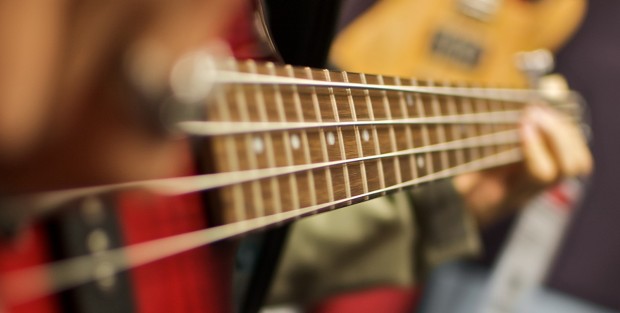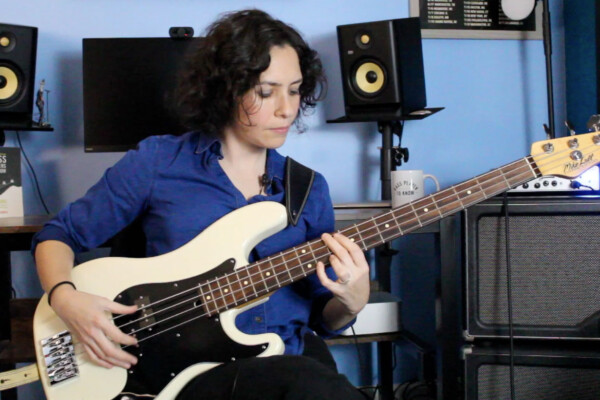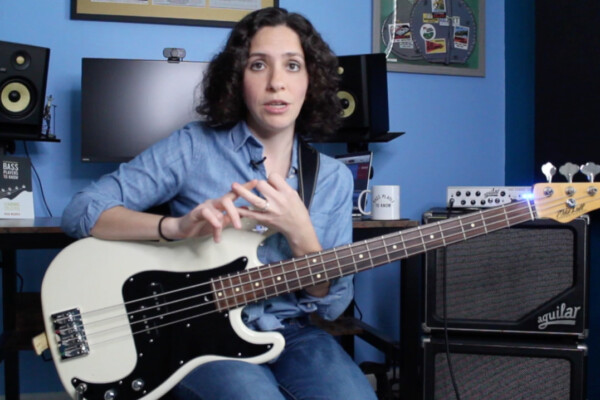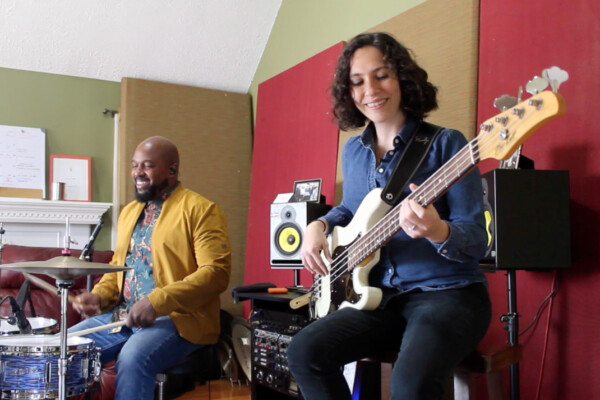Playing Over Long Lasting Chords

Q: I’ve been messing around with playing over the changes, but I always stumble upon an issue: chords lasting 2, 4, 8 or even 16 bars! I know there’s a ton of different ways to approach this, but I have problems with approaching chord tones. Things like enclosures, double chromatics, diatonic and chromatic approach notes. How can I practice these concepts? What other tools or concepts are helpful when playing those LOONG chords?
A: You’re asking two (good) questions, so we’ll take them one by one.
Let’s start with scalar and chromatic practicing approach notes. Of course, everyone learns differently, so this might not be the best way for everyone to learn, but this is what worked for me.
When working on any the inclusion of any new harmonic concept, I start at the beginning. When I first started working on chromaticism and chromatic approaches, I started by adding them to already familiar patterns. Now, if we simply added chromatic approach notes to something like a major scale, we would really just wind up playing a chromatic scale, so I chose arpeggios.
First, I took my familiar arpeggio shapes and added chromaticism:
A C Major arpeggio (I always include the 7th, so it’ll be 4 notes): C E G B.
First, I would practice playing 8th notes and approaching each note of the arpeggio from a half-step below (B-C D#-E F#-G A#-B)
Then a half step above (Db-C F-E Ab-G C-B).
Next, I would surround the target note from above and below (Db-B-C F-D#-E Ab-F#-G C-A#=B).
Then below and above (B-Db-C D#-F-E F#-Ab-G A#-C-B).
Then I started adding double chromatic approaches using the same procedure (A#-B-C D-D#-E F-F#-G A-A#-B, and so on).
Next, I moved on to other familiar arpeggios (minor, dominant, -7(b5), diminished, augmented)
Once I got a little more comfortable with the concept, I moved on to playing tunes out of the Real Book and picking a chromatic device to play through every chord change, in real time (at a slow-moderate tempo). This puts you into more of a real life musical scenario and gets you moving through different types of changes, one after the other.
I also applied this type of work to every harmonic pattern that I was exploring at the time. For example, one of my favorite exercises is to arpeggiate the entire chord scale of a chord, through changes to a tune like “Stella by Starlight”, for example.
Arpeggiating the entire chord scale means that you are playing through the chord in 3rds: 1 3 5 7 9 11 13 octave (I tend to do this exercise at very slow tempos, playing 8th notes at one chord per bar. This is why I play the root at the top and bottom of the chord. 8 notes per chord instead of 7. You could always play that last 13 as a quarter note and give yourself a bit of a breath before starting the next chord).
Adding chromaticism to an exercise like this can really stretch your ability to think and play at the same time!
Now, this stuff is great for the shed but can sound a little mechanical if you only every do things in this way. Remember that we tend to play like we practice so it’s good to dig deeper and apply concepts in every way that you can conceive of.
Much of what I am actually thinking about when I play has to do with setting target notes for myself. I am operating on auto-pilot much of the time, trying to listen more than think and trust that the work I’ve down in the shed will translate on stage and my fingers will comply. I might be looking at a chord 1,2 or 3 bars away and thinking, “it’d sound nice to resolve this line on the 9 of that minor chord and let it hang there for a bit”.
My thoughts then immediately shift to, “ok, so how should I get there”? This is where this type of practice pays off. If you’ve been practicing this kind of thing, it shouldn’t be too hard to approach your target chromatically at the end of your line.
I often also add chromaticism in the midst of a line if I know that I want to land on X note and have more beats than scalar notes in between where I am and my target. (of course changing rhythm can have the same result but if I want to maintain an 8th note line and have 4 8th notes to move 3 notes away, chromaticism can be a nice way to equalize the rhythmic space with the harmonic space).
For example, if I want to land on an F on beat 1 of a measure, playing 8th notes, and I am currently a C on beat 2 of the previous measure in the key of C Major. One way I could fill the space would be to play C D E Gb F.
I could have, of course, played a G natural and kept it completely diatonic but that Gb chromatic approach to F gives it a little unexpected twist and still helps me to resolve the line well.
I hope that made a bit of sense. The important thing is to explore any concept as deeply as you can and try to think of new ways to apply it. Real Books are your friend. You have hundreds of chord changes and melodies sitting in front of you. Explore them all!
Now, you also asked about what to do when you have one chord type over an extended period. I assume that we are talking about improvisation and soloing and not walking but this could be applied to either.
I don’t have any real “exercises” for how to develop ideas over 16 bars of C7 but I can tell you that this is where all of your other work pays off. The more deeply you’ve explored harmony and melody, the more ideas you will have when it comes time to do a lot with a little.
The trick here is that it’s really up to us and our own musical senses to make our lines melodic. It’s easy when you have a million chord changes because they act like melodic training wheels. All you have to do is play some chord tones and “make the changes” and the line will have motion and make sense. Playing 16 bars of D-7 is another story. If you don’t try to play melodically and use phrasing, it’ll just sound like you’re playing a scale up and down the fretboard.
Here are a few things to keep in mind: – Just because nobody wrote changes in doesn’t mean that you can’t add your own. In fact, you very much should practice imagining common turnarounds and resolutions to give the line shape. Even just adding a basic ii-V can add some nice harmonic movement to your line.
Even if the changes aren’t diatonic to the chord you are playing, they will have context and will likely sound pretty cool in the end, as long as it’s still functional harmony (and not just random chords).
You should still set targets for yourself and explore ways to get from “here to there”.
Soloistically, you can play around with all associated modes surrounding your chord. If you have 16 bars of D-7, practice playing different scales from another related root. If you solo in C Major, that makes the D-7 sound Dorian (2nd mode of the major scale). You could also solo in A minor. F Major. You could also add a long minor ii-V to your D-7 giving you a bar of E-7(b5), a bar of A7(b9) and then resolving to your D-7. You can really go anywhere you want solistically, as long as it makes some kind of sense. In fact, when you do leave the diatonic harmony because you’ve added some of your own changes, it can sound that much cooler when you resolve it properly and bring everybody back “home”.
Adding your own changes is a common way for jazz musicians to add spice and flavor to any improvisation. It’s also a testament to the homework they’ve done in the shed because you can’t fake that successfully. You have to have spent some time in the shed exploring chord changes, relationships between them and melodic patterns you enjoy to navigate those changes.
One thing at a time, though. Diving into the deep end of the pool before you’ve learned to swim relatively well can be frustrating and self-defeating. You have to learn to cart-wheel before you can expect to land a back flip. Dig into a Real Book and explore harmonic patterns, approaches, resolutions, common turn-arounds, etc… It’ll all seep in and you’ll find that you have more ideas than ever when given some harmonic space to do your own thing.
Here are some more helpful columns here on No Treble that relate to these topics:
- Better Soloing: An Introduction to Key Center Improvising
- Approaches to Soloing
- On Musical Expression and Playing Freely
- Making Theory Work
- Turning Exercises into Real Music
Have a question for Damian Erskine? Send it to [email protected]. Check out Damian’s instructional books, Right Hand Drive and The Improviser’s Path.




Brilliant! Just guessing what about the left hand fingering? It’s better to slide from approach notes to target ones, or change the fingerling concept every time?
Either approach will have a different sound. It’s really about how you want to articulate the line. There is probably a half-dozen ways to do it so its all about what sound you want to make.
Thank you! Gonna try this!
–p